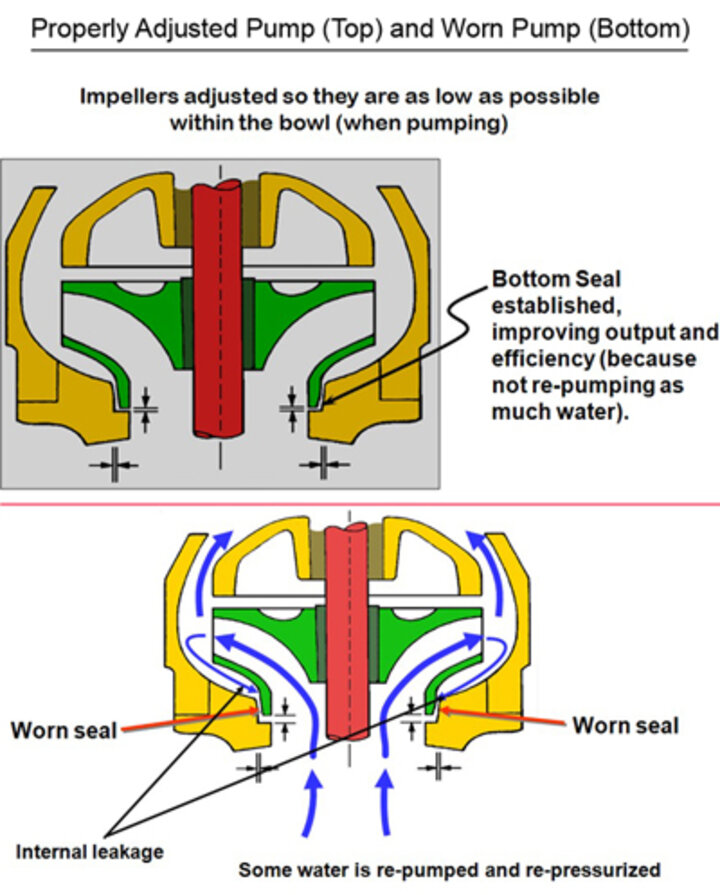
|
| Figure 1. (Top) A properly adjusted irrigation pump. (Above) A pump with worn seals will reduce efficiency, leading to wasted water, energy and input costs. |
April 3, 2009
This is one in a series of publications on Meeting the Challenge: Farming in Uncertain Times, written by specialists at the Panhandle Research and Extension Center. For more go to http://www.panhandle.unl.edu/meeting_challenge.htm
This is one in a series of publications on Meeting the Challenge: Farming in Uncertain Times, written by specialists at the Panhandle Research and Extension Center. For more go to http://www.panhandle.unl.edu/meeting_challenge.htm
When we think about getting the most out of irrigation water, efficiency is often the word that comes to mind. Yes, we do need to apply water in an efficient manner, but there are different ways to relate efficiency to irrigation.
Water and Pumping Plant Efficiencies
First, consider efficiency as it relates to water application. The goal when irrigating is to provide water to a growing plant, but if any of the water runs off of the field or moves below the plant's root system, application efficiency decreases because the plant can't use the runoff water. This is the primary reason that application efficiency of furrow irrigation systems is less than that of sprinkler systems. So whether we use furrow or sprinkler, keeping the water on the field and limiting deep percolation helps to improve efficiency.
Another kind of efficiency is pumping plant efficiency. The pumping plant is composed of both the energy source and the pump itself. Electric motors require very little adjustment, but diesel or combustible energy units will run more efficiently and use less fuel with proper maintenance and routine tune-ups. Equally important is providing periodic maintenance and adjustments to the pump itself, so it can deliver the optimum amount of water for a given quantity of fuel. The pump is completely out of sight, but wear and abrasion of sand in water can slowly reduce pump efficiency. A well maintained pumping plant will deliver the designed flow rate and pressure, thus improving system application efficiency.
| Table 1. Average dry bean and sugarbeet yields in Nebraska from 1989 to 2009. Shaded areas indicate drought years. (Source: USDA) | |||
| Year | Dry edible bean | Sugarbeet |
Corn |
| 1989 | 1,680 lb/acre | 18.8 tons/acre | 121 bu/acre |
| 1990 | 1,970 lb/acre | 21 tons/acre | 128 bu/acre |
| 1991 | 1,900 lb/acre | 20.2 tons/acre | 127 bu/acre |
| 1992 | 1,650 lb/acre | 17.9 tons/acre | 135 bu/acre |
| 1993 | 1,400 lb/acre | 18.5 tons/acre | 104 bu/acre |
| 1994 | 1,880 lb/acre | 20.3 tons/acre | 139 bu/acre |
| 1995 | 1,750 lb/acre | 16.4 tons/acre | 111 bu/acre |
| 1996 | 1,900 lb/acre | 17.8 tons/acre | 143 bu/acre |
| 1997 | 2,060 lb/acre | 16.8 tons/acre | 132 bu/acre |
| 1998 | 1,950 lb/acre | 19.7 tons/acre | 145 bu/acre |
| 1999 | 2,000 lb/acre | 19.0 tons/acre | 139 bu/acre |
| 2000 | 2,070 lb/acre | 20.3 tons/acre | 126 bu/acre |
| 2001 | 2,150 lb/acre | 20.3 tons/acre | 147 bu/acre |
| 2002 | 2,100 lb/acre | 18.1 tons/acre | 128 bu/acre |
| 2003 | 2,130 lb/acre | 20.3 tons/acre | 146 bu/acre |
| 2004 | 2,160 lb/acre | 22.1 tons/acre | 166 bu/acre |
| 2005 | 2,250 lb/acre | 20.4 tons/acre | 154 bu/acre |
| 2006 | 2,200 lb/acre | 23.3 tons/acre | 152 bu/acre |
| 2007 | 2,260 lb/acre | 23.5 tons/acre | 160 bu/acre |
| 2008 | 2,290 lb/acre | 22.6 tons/acre | 163 bu/acre |
A worn pump allows water to escape through the seal formed between the impeller and the pump bowls. When the seal gets worn, water must be pumped several times before being delivered to the surface. UNL has conducted tests over the years and has found that, on average, pumps are using 30% more energy than should be needed. Given today's energy costs, poor pumping plant efficiency can be costly (see Figure 1).
Because of drought, irrigators have had to manage water efficiently. Although the drought has eased the past couple of years, we know that droughts occur in cycles and we will see dry periods again. It is interesting to observe what has happened to crop production during the last drought cycle.
Drought Doesn't Always Reduce Yields
We would expect that drought years would bring lower crop yield. But according to statistics from USDA, that is not necessarily the case. Listed are average corn, dry bean, and sugarbeet yields in Nebraska over the past 20 years.
It is interesting that, during the drought years of 2002-2007, crop yield was actually greater than during the previous 10 years when rainfall was more plentiful and irrigation water more than adequate to meet crop demands. Certainly there have been other improvements in crop production practices, but it is important to note that a shortage of water did not automatically mean lower crop yields.
Potential Impact
Improving irrigation-related efficiencies, and ultimately getting the most out of irrigation water, means giving the plant the water that it needs without over-irrigating. Over-irrigating increases pumping costs, depletes water resources, and can decrease crop yield.
For additional information on the effects of over-irrigation, see the NebGuide, Plant Growth and Yield as Affected by Wet Soil Conditions Due to Flooding or Over-Irrigation (G1904).
C. Dean Yonts
Extension Irrigation Engineer, Panhandle REC
Bill Kranz
Extension Irrigation Engineer, Northeast REC
